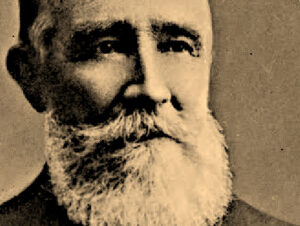1860: The West Coast Purchase
May 21, 2023
By AHNZ

Today in history, 21 May, 1860, 100 or so Ngai Tahu sold the entire West Coast of the South Island to the Crown.
James Mackay paid the natives just $40,000 (£300.) The gold alone mined from these lands would be $2.8 billion. It was a sweet deal and Greymouth’s main street to this day is named Mackay Street.
Mackay was quite prepared to have paid more if he needed to. The Grey River was in flood (as it also is now, 21 May, 2022) and toppled Mackay’s canoe. Somehow he not only survived with the deed but also made it to the northern bank with the remaining 100 sovereigns the Maori dealers missed out on.
Interesting to note that the site of the deal, Mawhera Pa (future Greymouth) was a busy place that day. Mackay’s expedition was there and so was the Haast expedition. The schooner Gipsy the arrived too, making a supply drop as one of the first ships ever to cross the Grey Bar.
“Mr Mackay purchased the West Coast from the remaining 110 surviving male Maoris and paid them 300 gold sovereigns at Greymouth on May 21, 1860….The Maoris reserved the principal portion of the town of Greymouth for themselves. From the town land only, in 1900, they received about £5000 in rents, which European industry and enterprise had rendered so valuable, while the Maoris lived in idleness at the Arahura. Arahura may mean to ” find a path.”” – Roberts, Otago Witness (1910,) Papers Past
“It was generally considered impossible for Mackay not to have known of the gold. The Oakes brothers and Messrs Harper and Locke had reported it to the Canterbury Provincial Government three years before the sale, the Nelson Examiner had actually published the fact that the Maori brothers Tarapuhi and Tainui had found it “in abundance” in 1858, and, most important of all, Mackay’s friend John Rochfort had reported its discovery at the Old Diggings a year later. Again Mackay was a Goldfields Warden and, as such, was known to have a good knowledge of the metal royal. Further, von Haast and his assistant, James Burnett, were on the spot and surely, if only out of curiosity, must have panned a dish or two of wash, and by so doing, proved that gold was existent everywhere.” – The Golden Grey, Tony Kokshorn (2011)
Mackay certainly knew about the gold and knew he had to get ahead of the gold rush. The Maoris had known since at least 1858 although the scale and importance they could hardly have suspected. At any rate, the natives did very very well out of their sale. Especially so considering that this tribe had, only a generation or 2 earlier, slaughtered and kicked out the previous tribe! The new transition was far more civilised.
—
Ref. RBNZ Inflation Calculator
Image ref. James Mackay, Alexander Turnbull Library; AHNZ mod
Ref. 1880: Death of Chief Tainui, AHNZ
15 thoughts on "1860: The West Coast Purchase"
Leave a Reply
 Like Comment Share
Like Comment Share






Thanks for that. Leaves me with some questions such as : Have any remnant Maori tried for compensation from their Maori conquerors.
Moriori and Muaupoko in Otaki/ Levin taken out and hounded by Te Rauparaha come to mind.
under what law and currency does this “compensation” get paid out?
Not a chance. Ngati Wairangi were destroyed in about 1795. Even their sacred burial grounds such as the caves at Mawhera Pa and up stream at Rocky Island were desecrated. The ancestors’ remains cleared out and disposed of in deliberate acts of colonisation/hegemony.
Even if there were a body of Wairangi left over from the 1700s who retained their identity to the 1860s who would care? With no territory some defeated people would have to pass on their distinct sense of culture in the hopes 2020s Social Justice coming in to being so they could play a victim card. That’s too much of a a long game for anyone!
Ref. also 1880: Death of Chief Tainui
https://ahnz.anarkiwi.co.nz/1880-burial-of-chief-tainui/
My novel, ‘The Bird Talker’ was written around Ngati Wairangi (Ngati Wherangi) including their interaction with Ngai Tahu (Kati Timu) in the Grey Valley over access to ground birds (circa 1600). From my research I came to the conclusion that both tribes were related & originated from the Hawkes Bay region of the North Island. Jack Roberts
Jack, when Brunner came down about the Grey Valley he found areas where food was very scarce and it nearly killed his part. Maoris included. Yet you think it was otherwise at an earlier date?
Yes, I am writing some 250 years prior to Brunner’s exploration. There was competition for ground birds. Moa were already primarily extinct & flightless birds like takahe, kakapo, geese, ducks, kiwi, swans etc were primarily gone due population demand & use of fire east of Maruia & Alps. Ngati Wairangi practised management of these species in Grey Valley so they were plentiful circa 1600 but of course declined along with loss of the Wairangi people
Well that’s fairly interesting. Wairangi were ousted in c.1800 and Brunner couldn’t get a feed in the 1840s. My premise would have been that there never was anything much for people to eat in those places. But you’ve found evidence that there was?
ummmm??? paua eels fish birds puha kei kei kumara potatoes pork…
Brunner and his Maori guides almost died of starvation here in the 1840s, finding it a dead zone. Even had to eat his beloved dog. I can share the text if you’re interested. The journal is online.
What was the origin of Ngati Wairanga? Were they of the same generation as Waitaha or Patupaiarehe?
Ngati Wairangi came to the West Coast from Nelson and before that from western districts of North Island. This was in the C15th. I think they were contemporary of Waitaha who were living on the east coast of the South Island and pre-date the C14th Polynesian arrivals.
Basically agree your description. There was definitely interaction between Ngati Wairangi & south Taranaki tribes. I believe they then came south via D’Urville area & west via Mahua (rather than Nelson) but I maintain a belief that both Ngai Tahu & Ngati Wairangi left Hawkes Bay around the same time & were related, Ngai Tahu going south via Wairarapa & Ngati Wairangi west via the Whanganui.
Sorry, Mohua, not Mahua.